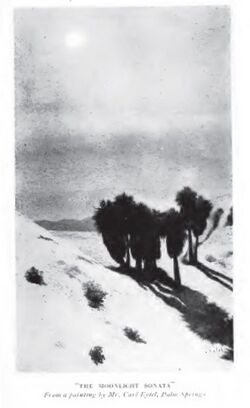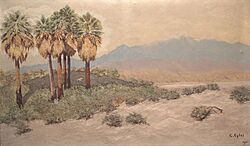Carl Eytel facts for kids
Quick facts for kids
Carl Eytel
|
|
|---|---|

Eytel sketching – during his trip with George Wharton James, c. 1900
|
|
| Born |
Karl Adolf Wilhelm Eytel
September 12, 1862 Maichingen, Kingdom of Württemberg, German Confederation
|
| Died | September 17, 1925 (aged 63) Banning, California, U.S.
|
| Resting place | Jane Augustine Patencio Cemetery, Palm Springs, California |
| Nationality |
|
| Education |
|
| Known for |
|
|
Notable work
|
Desert near Palm Springs (1914) now in the California State Library California History Room |
| Movement |
|
| Patron(s) | Martha M. Newkirk |
Carl Eytel (born September 12, 1862 – died September 17, 1925) was a talented German American artist. He became well-known for his beautiful paintings and drawings of the desert. His art focused on the American Southwest.
Eytel moved to the United States in 1885. He later made his home in Palm Springs, California in 1903. Carl Eytel knew a lot about the Sonoran Desert. He traveled with author George Wharton James and helped him create the famous book Wonders of the Colorado Desert. Eytel drew over 300 pictures for this book, which came out in 1908. Even though he was a successful artist, he lived a very simple life and passed away without much money. One of his most important artworks, Desert Near Palm Springs, is now in the California State Library.
Contents
Carl Eytel: Artist of the Desert
Early Life and New Beginnings
Carl Eytel was born Karl Adolf Wilhelm Eytel. His birthplace was Maichingen, in what was then the Kingdom of Württemberg, Germany. This area is now part of Baden-Württemberg, near Stuttgart. His father was a Lutheran minister. When his father passed away, young Carl became a ward of his grandfather.
Carl received a good education at a German gymnasium, which is like a high school. He became very interested in the American West. This happened after he read books by Alexander von Humboldt. Humboldt was a Prussian writer and explorer who wrote about natural science. Carl found these books in the Royal Library in Stuttgart.
From 1880 to 1884, Carl studied forestry. After that, he joined the German Army. In 1885, he first traveled to the United States on a ship called the Suevia. He worked as a ranch hand in Kansas. Later, he worked at a slaughterhouse for 18 months. This helped him earn money and learn about cattle. In 1891, he read an article about the Palm Springs area. This made him want to visit the California desert.
Living in Palm Springs
Eytel went back to Germany to study art for 18 months. This was from 1897 to 1898 at the Royal Art School Stuttgart. Then, he moved back to the United States. He wanted to be a cowboy and worked as a cowhand in the San Joaquin Valley. In 1903, he finally settled in Palm Springs.
He lived in small cabins that he built himself. Palm Springs became his permanent home. Eytel often walked long distances on his trips. He once walked 400 miles across the Colorado Desert. He lived a very simple life, often struggling to make ends meet.
Carl Eytel's Art and Collaborations
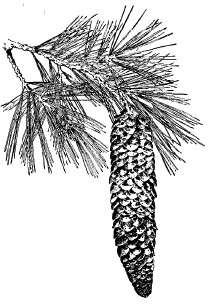
Carl Eytel traveled alone across the American Southwest. He also joined author J. Smeaton Chase and painter Jimmy Swinnerton on their journeys. He was a guide for George Wharton James. Eytel showed James "every important and hidden location." He then illustrated James' two-volume book, The Wonders of the Colorado Desert.
This book was very successful and received good reviews. Their work on the book lasted from 1903 to 1907. Eytel's drawings were also used by James in his 1906 article. This article was called "The Colorado Desert: As General Kearney Saw It."
Famous Works and Support
By 1908, Eytel was showing his art in Pasadena. He also received support from a wealthy socialite named Martha M. Newkirk. He planned to build a small house in Beaumont, California. In 1909, his art was shown in major art places. These included the Kanst gallery in Los Angeles.
Later, in 1911, he traveled with Chase on horseback. He then contributed 21 realistic line art drawings to Chase's book. This book was titled Cone-bearing Trees of the California Mountains.
Besides his work in Wonders of the Colorado Desert and Cone-bearing Trees, Eytel also contributed drawings and articles to popular magazines. These included the Los Angeles Times and, for almost 14 years, the New Yorker Staats-Zeitung. During his travels, he became friends with Charles Fletcher Lummis. Lummis was the city editor for the Los Angeles Times.
A stone wall in Dr. Welwood Murray's early hotel had a large painting by Eytel. It showed Palm Canyon. His hundreds of drawings of native palms became his special style. He was known as "The Artist of the Palms." His art helped make early Palm Springs famous. In 1977, his works were selling for a lot of money.
The "Creative Brotherhood"
Carl Eytel was a key member of a group called the "Creative Brotherhood." This group lived in Palm Springs in the early 1900s. Other members included naturalist Edmund C. Jaeger, and authors Chase and Charles Francis Saunders. Cartoonist and painter Swinnerton, author James, and photographers Fred Payne Clatworthy and Stephen H. Willard were also part of this group.
These men lived close to each other. Like Eytel, Jaeger built his own cabin. They traveled together throughout the Southwest. They helped each other with their works. They also shared photographs that appeared in their different books.
The Brotherhood started in 1915. This was when Jaeger, a teacher in Palm Springs, met Eytel and Chase. It ended in 1923 when Chase passed away. Jaeger wrote a tribute for Eytel after his death. In 1948, Jaeger remembered Eytel, saying:
As an artist Eytel was largely self-taught.... Not widely schooled, but widely read. Eytel possessed a knowledge not only of the Greek and Roman classics but of the best literature of England, America and his native Germany. I never knew Eytel to sleep indoors. Trying to inure himself to hardships in the belief it would toughen his constitution....
Eytel was seen as the "spiritual leader" of the group. Even after Jaeger left for college and Chase got married, the four friends often wrote letters to each other. Eytel stayed in Palm Springs and faced financial difficulties. Swinnerton would often buy art supplies for him. Later, Eytel became more private.
The "Smoketree School"
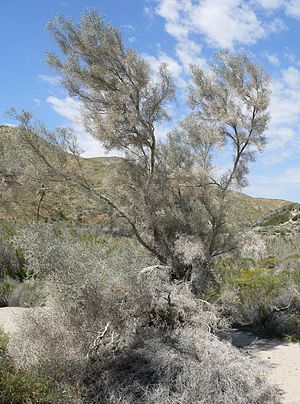
Journalist Ann Japenga described Eytel's art as part of the "Smoketree School." This art style is named after the smoketree, a popular desert subject for artists. The school was influenced by artists like Alson S. Clark and Jack Frost. They, in turn, were inspired by the French impressionist Claude Monet.
Other artists in the Smoketree School included Carl Bray, Fred Chisnall, Maynard Dixon, Clyde Forsythe, Sam Hyde Harris, John Hilton, R. Brownell McGrew, Agnes Pelton, Hanson Puthuff and Swinnerton.
What Carl Eytel Painted
Like many artists of the desert Southwest, Eytel's style was impressionistic. This means his paintings often captured the feeling or mood of a scene. His subjects were varied. They included the Mission San José de Tumacácori in Arizona and California's Mission San Gabriel Arcángel and Mission San Juan Capistrano Spanish missions.
His drawings for Cone-bearing Trees of the California Mountains and Wonders of the Colorado Desert were very detailed. They showed Desert Bighorn Sheep, desert reptiles, and cattle. His painting Mirage in the Desert (1905) for Wonders shows cattle and cowboys.
Eytel also painted the lives of the Navajo, Hopi, Cahuilla, Serrano and Kamia peoples. He drew landscapes of the New Mexico Eight Northern Pueblos in San Ildefonso, Laguna, Tesuque and Taos Pueblo. He also drew the Walpi Pueblo on First Mesa, Arizona, and the Cocopah people near Calexico, California.
He drew prospectors working in mines like Anaconda and Manana in Arizona. He also drew the famous Picacho gold mine. Other scenes included the Rancho Guajome Adobe near Encinitas, California, the Sierra Bonita Ranch near Fort Grant, Arizona, and turn-of-the-century Tucson, Arizona. He also drew the Yuma Territorial Prison, in Yuma, Arizona.
His pictures of early Palm Springs included the stagecoach station. He also drew William Pester, known as "The Hermit of Palm Springs."

Eytel's landscapes and mountain scenes in Wonders included:
- Ehrenberg, Arizona
- Algodones, with the Pilot Knob landmark
- Palo Verde, Arizona
- San Jacinto National Forest, California
- Oak Creek Canyon, within Coconino National Forest, Arizona
- Mt. San Gorgonio, California
- Mt. San Jacinto, California
- Royal Gorge, Colorado
- San Francisco Peaks near Flagstaff, Arizona
- Sentinel Rock and Cathedral Spires in Yosemite Valley, California
- Tahquitz Peak, near Idyllwild, California
- Twin Buttes, Navajo County, Arizona
Remembering Carl Eytel
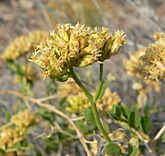
Eytel was a friend to the Cahuilla people. They allowed him to be buried in their cemetery in Palm Springs. He passed away in a Banning, California sanatorium. Nellie Coffman, who started the Desert Inn in Palm Springs, arranged his funeral and burial.
Saunders wrote a tribute for Eytel in August 1926:
But to Carl Eytel, pioneer of Palm Springs artists, working there long before the world of fashion had heard of the place, Palm Springs was his home, and the desert his life. He knew it in all seasons, in all moods, and he painted it with a sort of religious ardor springing from unfailing love, in season and out. Others have been better draughtsmen than he, but when you look at a canvas by Eytel at his best you are looking into what seems the desert’s heart.
His painting Desert near Palm Springs (1914) is shown in the California History Room. This room is part of the California State Library. The Palm Springs Art Museum has many of Eytel's sketches and paintings on display.
A desert plant called amphipappus fremontii was given the name "eytelia" in his honor. A short street in Palm Springs, "Via Eytel," is named after him. There is also "Eytel Road" in nearby Cathedral City.
See also
|
Art topics:
|
Literature topics:
Desert topics:
|


